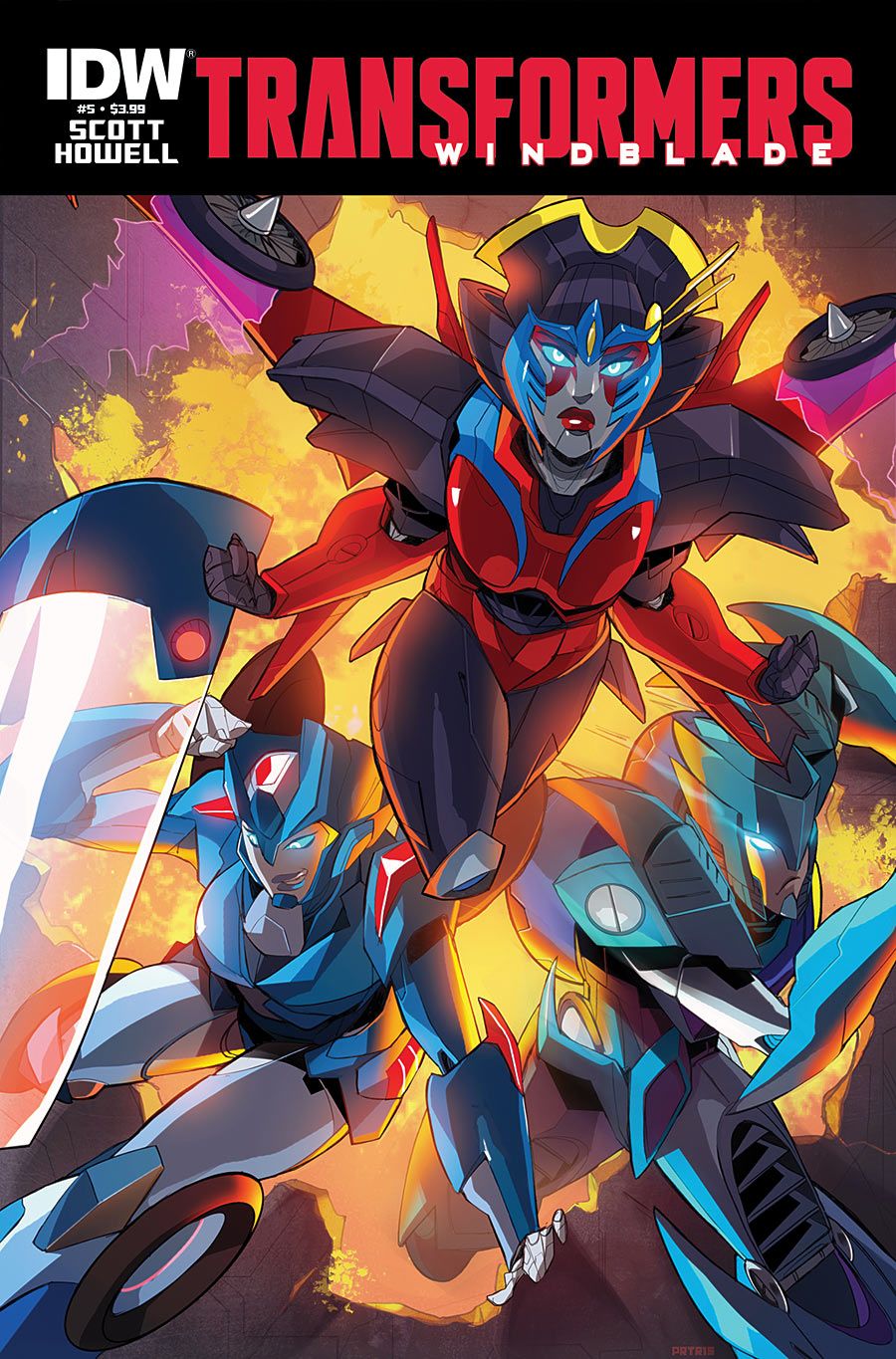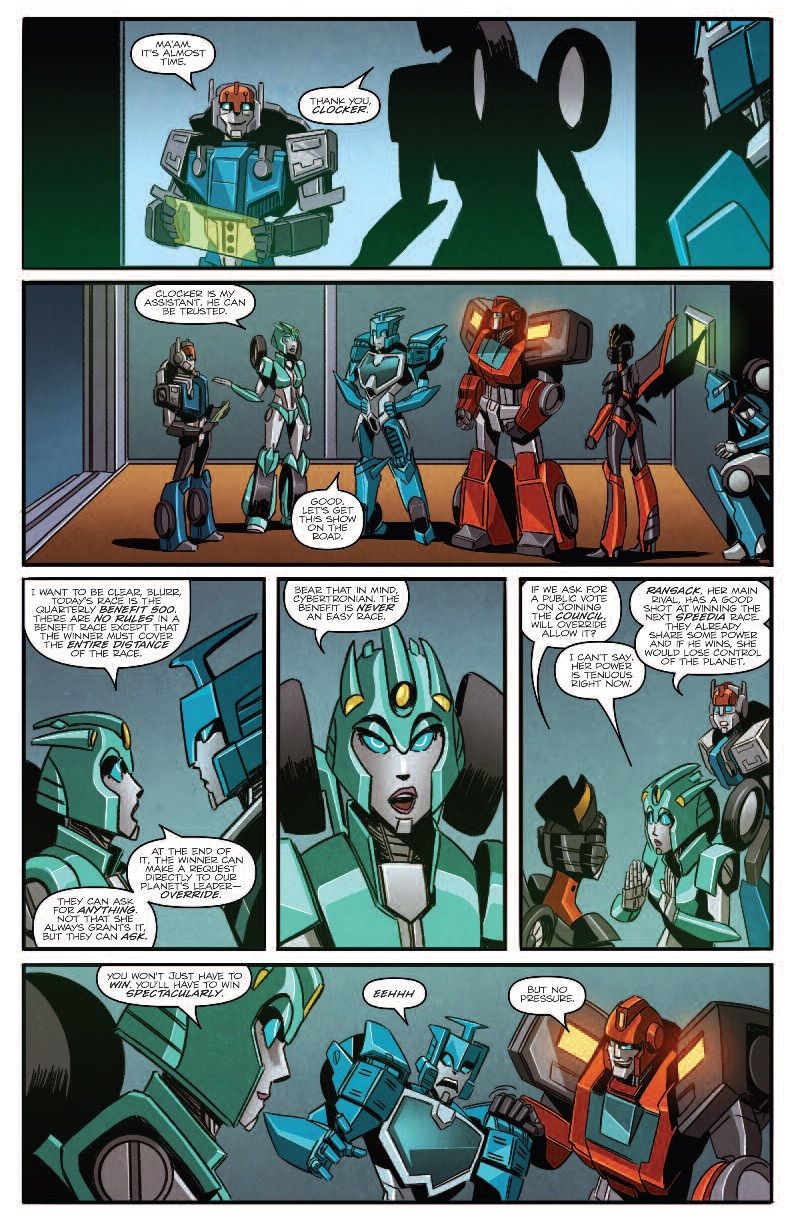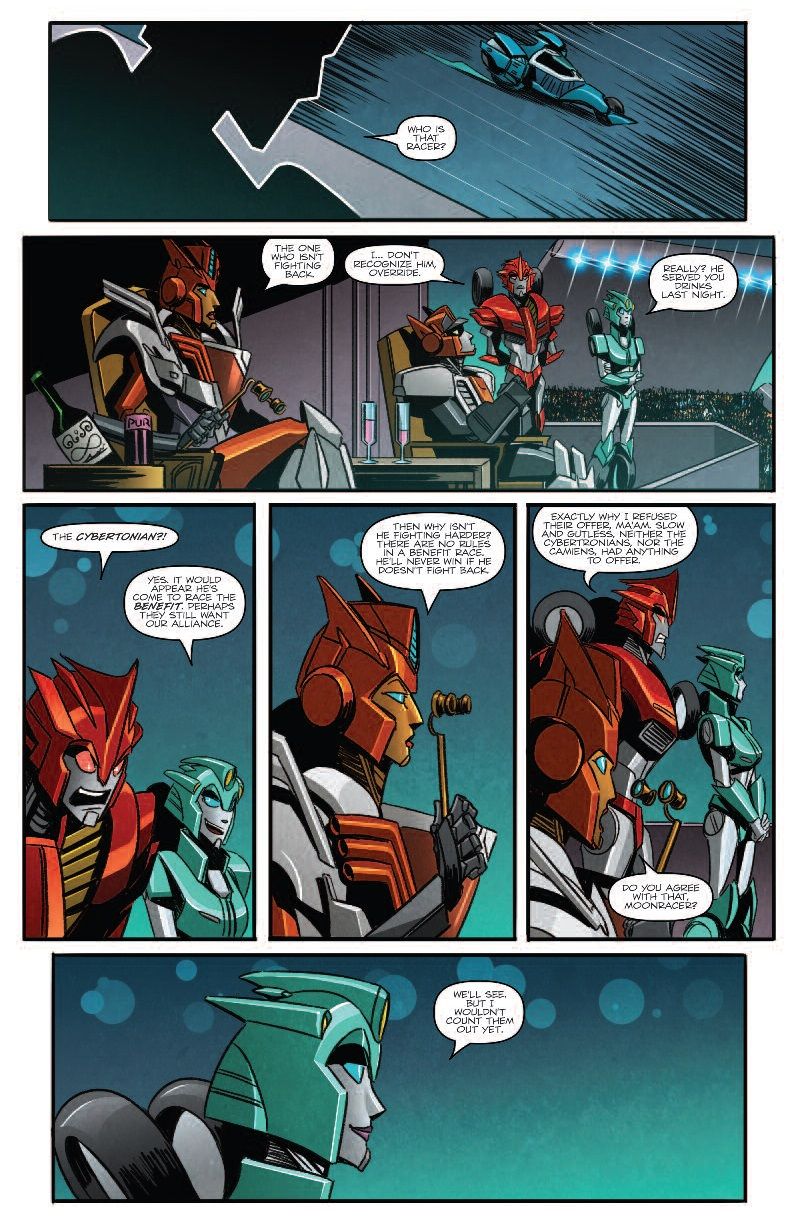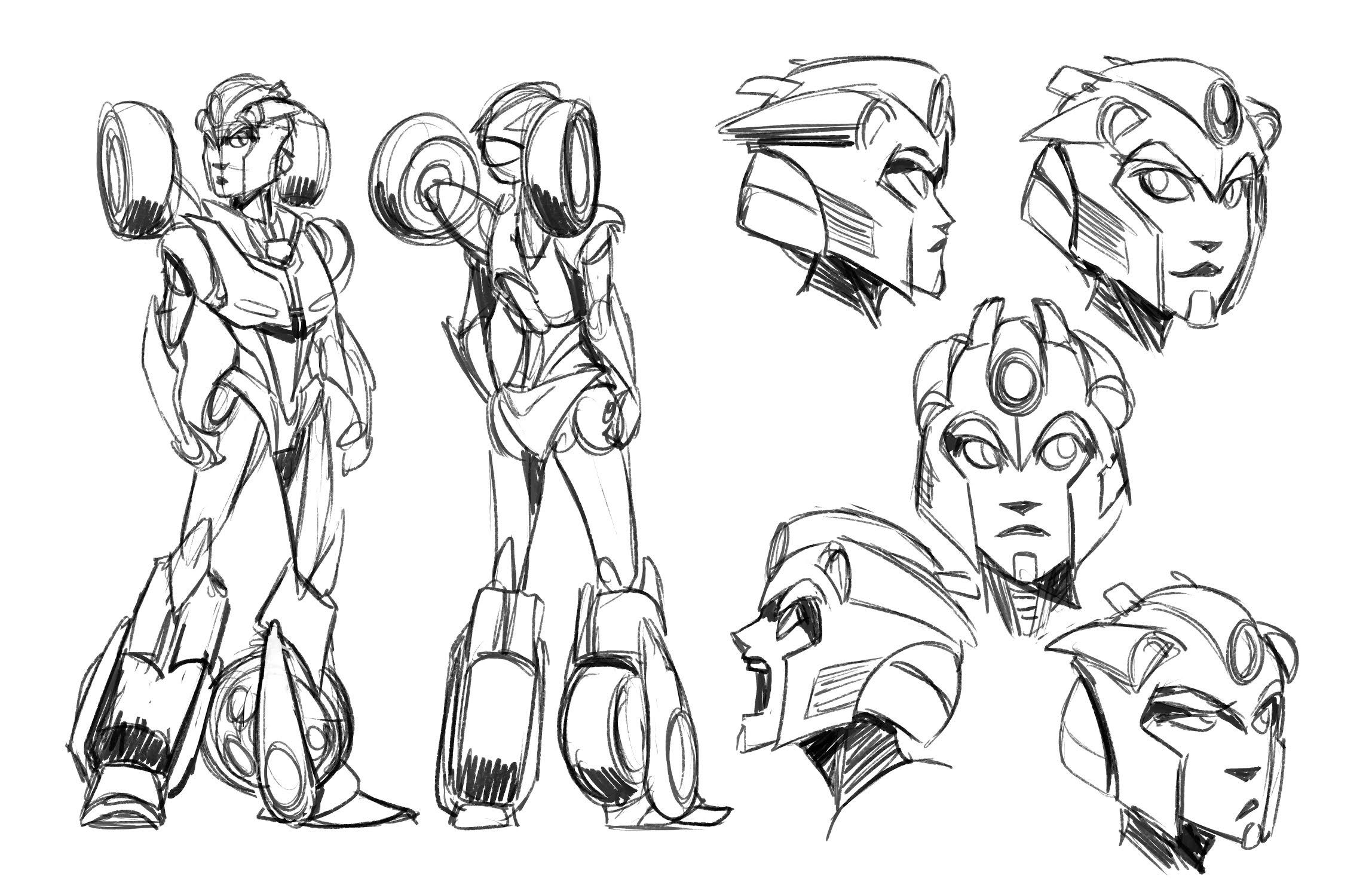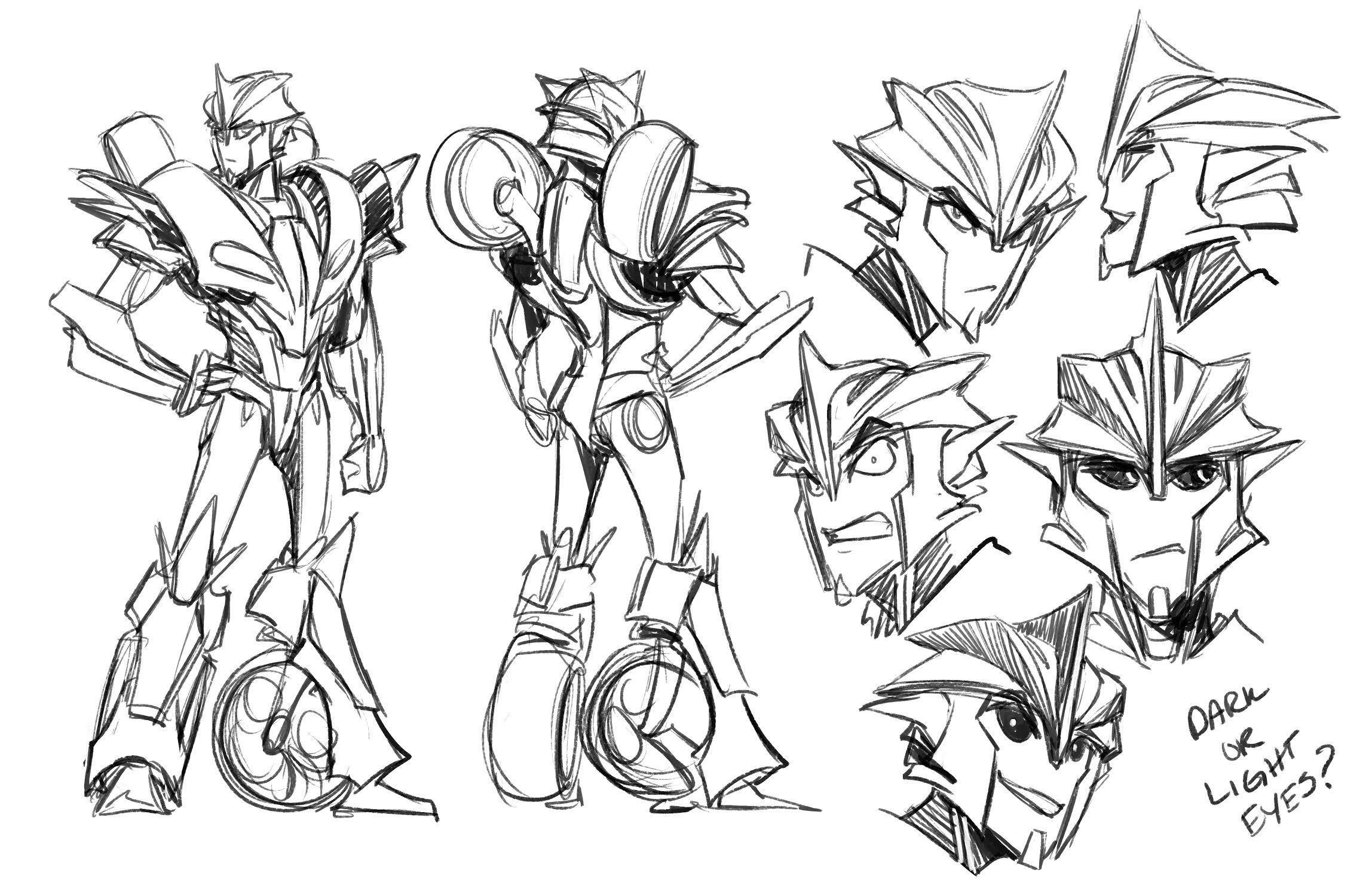Over the course of IDW Publishing's "Combiner Wars" event, a number of the most high-profile characters in the Transformers Universe clashed with one another. Optimus Prime, Starscream, Windblade and Prowl were all pulled into the thick of an event, the scale of which seemed impossible.
As the final moments of the "Combiner Wars" arrived, a host of new character joined the Transformers' robotic ranks. And though the event is now over, things have not slowed down as it continues to affect the lives of all involved -- especially Windblade, whose ongoing story lies in the hands of writer Mairghread Scott and artist Corin Howell.
CBR News spoke with Scott and Howell about what's next for "Transformers: Windblade," what it means for their title character to learn that Prime may not be the 100% altruistic hero she once believed him to be, and why giant, battling robots provide the perfect allegory to explore themes like politics, war, gender and more.
As "Combiner Wars" unfolded, things became incredibly tense. Starscream, Optimus Prime and Prowl all clashed, and Windblade was pulled into the thick of it. What's her reaction to all this? Where does she stand right now?
Mairghread Scott: Windblade and Chromia have always feared that Cybertron's war might spill over to their homeworld, Caminus, and now it has. At the same time, Cybertron reaching her homeworld means Windblade's people can finally get access to the resources they desperately need. So Windblade's main conflict is how much of Caminus's freedom she's willing to give up in order to save her people. Of course, with Prowl and Devastator now in the mix, Windblade is not only coming into conflict with Starscream but also with Optimus to some degree. No one is safe in "Combiner Wars," and no alliance is safely in or out of bounds.
One of the most interesting parts of the story so far has been the interaction between Windblade and Optimus Prime. She started off being somewhat in awe of him, but now she's starting to see his conflicts and compromises. Is she starting to see a more morally grey universe?
Scott: IDW Transformers has been exploring this question for a while now and that's my favorite aspect of our comics. No one fights eons of war without truly believing in something and no one walks out of eons of war cleanly. Even Optimus Prime has compromised his morals at some point. And there's a really nice point of contrast here because while Windblade covered up her best friend Chromia's misdeeds, I'm not sure how she'll react to the fact that Optimus has shielded Prowl from the consequences of a lot of his actions, actions which now harm her homeworld and her people.
Regardless of her beliefs, Windblade comes from a people who worship the Primes as deities. But the longer "Combiner Wars" continues, the more Windblade is going to see Optimus as a real, flawed person. Seeing Optimus lose his "divinity" will be a real challenge for her.
Starscream has been handling this all magnificently, maneuvering everything into place. Has it been fun to get to have him outpace the others and show off his political agility?
Scott: Starscream is one of my favorite characters and I've had a great time revealing just how cunning he is. He also has a big advantage because everyone else in the book wears their heart on their sleeve. Windblade wants to save Caminus. Optimus wants to save Cybertron. And Starscream just wants to do whatever's best for Starscream. That makes him a lot more flexible than our other characters, and he uses that flexibility to its fullest extent. When Starscream sent Swindle and Menasor to Caminus, I saw a lot of people exclaiming that this would be Starscream's last mistake, and by the end of "Combiner Wars" he'd be ousted from power. I think underestimating Starscream is a lot of people's biggest mistake.
Scott: So at the end of "Combiner Wars," Caminus and Cybertron are now connected via SpaceBridge, and the Cybertronians have learned of at least four other colonies. Windblade's new mission is to make first contact with these worlds and somehow convince them to ally with Cybertron's new Council of Worlds, but each colony will have its own unique challenges she'll have to deal with. We're also kicking open a lot of doors to continuities that haven't been explored much in IDW. We're including a whole lot of new Transformers, many of which fans will know from other iterations of the brand throughout the years.
And you're now joined by artist Corin Howell for the next stage of Windblade's story. How have you found working with one another?
As this new storyline continues on past "Combiner Wars," what can readers expect from the series? Will the event continue to have repercussions for Windblade?
Scott: Corin's art first appears in "Windblade" #3 (along with the great Marcelo Ferreira), and I couldn't be happier about it. Her work is incredibly expressive. Since the next arc of "Windblade" focuses on exploring other colonies, I wanted readers to instantly get a sense of who these people are and what their outlook is. Having an artist like Corin, who can balance body language with facial expressions, and humor with action, is imperative to that goal. Her characters feel incredibly alive and we're getting a lot out of each image because of that. Also, I've noticed that Corin hides fun little things in the background that that really flesh out the world, so keep your eyes peeled.
Corin Howell: It's fantastic working with Mairghread. She gives me freedom when it comes to designing scenes. Despite the fact that I have to keep to specific character designs, I have a lot of room to experiment when it comes to landscapes and camera angles. Mairghread always has a really good sense of direction on the tone of each scene, and since I like to be expressive with my characters, that really helps me pull those emotions out of them when I am putting lines on the page.
Corin, for you this is "mission accomplished" -- you've been wanting to draw a Transformers story for quite some time! How did you get involved in joining the story at this point?
Howell: I've been a huge fan of Transformers since I was a kid, and I've always wanted to get involved with the comics, so getting this chance was truly amazing. I met [IDW Senior Editor] John [Barber] and Mairghread at SDCC last year, and I basically expressed how much of a Transformers nerd I was (by accident, because I actually didn't recognize them at first) and ended up showing them some of my work. Then, this past February, I got an email from John asking me if I would be interested in doing some issues for "Windblade." And here we are!
The Transformers comics seem to handle sci-fi as allegory more capably than anyone else is able to right now. What is it about the Universe which makes them so suitable to introduce themes of politics, war, gender and the like?
Howell: I think it's because when you get to see huge talking robots fighting, you can be sneaky with some bigger themes like political disputes and rivalries or the cause and costs of war. Everyone reads it to have fun, but they come away with a little bit more than that -- or at least that's the hope, anyway.
Scott: When you are dealing with alien robots, you have just enough distance between you and the subject that you can explore difficult ideas and themes much more comfortably. "Transformers" as a brand has always dealt with war, battle fatigue, prejudice and factionalism. And while our main goal is to tell a really great story, it's always my hope that we're giving people the chance to explore the rationale, emotions and beliefs of people they wouldn't get the chance to do in real life.
We've really seen a whole roster of female Transformers over the last few months. What do you think their arrival has brought to the Transformers Universe?
Howell: I think it has opened up a lot of doors. I know a lot of girls in the Transformers fandom that love the IDW series but were always concerned that there weren't enough girls in the series. Now that we have new female characters coming into the series, there's a bit more gender equality amongst the bots. Which is cool because these aren't just comics for girls -- they're comics for everyone.
Those characters were spotlighted in July's "Combiner Hunters" one-shot. How did that issue come about?
Scott: Several months ago, John Barber, James Roberts and I sat down to discuss how Windblade, Chromia and Nautica were a good start towards more diversity -- but that we all wanted to do more. James had plans for Nickel and a bunch of new bots showing up in "More Than Meets The Eye." John has some big plans for Transformers. I wanted to use the colonies to introduce more female Transformers but also other types of bots from different parts of the brand. It was a great start. Later, John talked to me about writing a special one-shot for this July that would introduce the new fan-built combiner.
At the time, the voting wasn't finished so we didn't know what kind of bot the combiner would be, but we knew we wanted to build a story around Arcee, Chromia and Windblade set at the end of "Combiner Wars." Once we learned that the results of the vote had created Victorion, and that she would be made up of six female characters, we realized we had a great opportunity to tell a one-shot story almost entirely about female Transformers. In fact, I had so many lady bots running around I couldn't use "she" in the script because it was too confusing to figure out which of our nine ladies I was referring to. So this summer, fans can pick up "Combiner Hunters," meet the bots who make up Victorion and get a great story that involves Windblade, Chromia and Arcee.
The best part had to be writing Chromia and Arcee, who are just constantly trying to one up each other. Which is a good thing because as great a diplomat as Windblade is, she's still not exactly someone you'd be afraid to meet in a dark alley.
I want to ask specifically about two of the characters you're helping to introduce here. The first is Moonracer. How did the design come together for the character? What did you want to emphasis about her?
Scott: Moonracer is one of our new Velocitronians who shows up in issue #3 and is prominently featured in issues #4 and #5. The main design note for all Velocitronians is that they are built for speed, so they had to feel thinner and lighter than Cybertronians.
Howell: Moonracer took a moment to figure out since there are quite a few versions of Moonracer out there, not to mention the only version I really remember is the Moonracer from "Gen1." So when Mairghread was explaining what Velocitronians were like, I knew I had to make her more lightweight to fit her world but also make sure she was expressive. So I decided to take some designs from "Transformers Prime" and give a hint of "Gen 1" to her. I made her more like a racing smart car, with a "Gen 1" type helmet and a very slender "Transformers Prime" inspired build for her frame. Mairghread best described Moonracer, which helped steer towards how I should portray her: intelligent, cute, reserved and incredibly capable.
Scott: Moonracer's biggest design points were making her seem a bit younger than her G1 design and making her look well-designed but somewhat forgettable. Moonracer is someone who's been pushed to the side and overlooked by her society so I wanted her to look like someone you could meet and forget at a party. There's nothing flashy about her. That's not to say Moonracer is a wallflower, but when your boss/colleague is Knock Out you aren't going to be able to out-anything him. Moonracer is smart enough to know this and we'll see that her shy violet attitude is as deliberate a strategy as Knock Out's "look at me, look at me"-ness. She knows she's only going to get one sentence in any conversation, so she makes sure it counts.
And then there's the arrival of Knock Out, as you mention. What drives (pun intended) the character, to your mind?
Scott: So many fans know that I've wanted to introduce Knock Out to the IDW verse for a while. Velocitron gave me a great way to introduce him and keep much of his personality intact. For this iteration of the character, he is still very vain and obsessed with his appearance, and thinks of practically everyone as beneath him. Corin did a great job of making Knock Out "act" with as big a personality as he had in "Transformers Prime." He makes his grand, sweeping gestures. He's designed to take up a lot of room on the page and it works tremendously well with Moonracer standing next to him looking completely over it. There's also a little bit more pathos we were able to give a nod to in this version of Knock Out, but you'll have to read closely to catch it.
Howell: Knock Out in terms of design was simple: take his "Transformers Prime" design and tweak it just a bit to make him more slender. Knock Out is kind of like Starscream in my mind minus the wings: he likes to race, he likes to look good and he likes to be the best of the best. I often referred to Knock Out as "The Sass-Master," considering the amount of sass-tastic, smug attitude that he constantly portrays. He's the complete opposite of Moonracer.
Was it a conscious choice to pick characters from so many different versions of the franchise and unite them here?
Scott: My goal for introducing more diversity to the brand has always been about opening as many doors as possible. I never want a writer to think "I can't introduce Character X because they have no place in this universe." So Caminus got the ball rolling on introducing female Transformers, but now all these other colonies will have female Transformers, too. My next thought was how can we push this further and introduce more bots. I realized that we had a lot of G1 and G2 bots but what if you grew up with "Beast Wars" or "Animated" or any of the later generations of Transformers? I wanted something for those viewers, too. These colonies have allowed me to open even more doors and create a whole universe of possibilities for future stories and future characters. I want any fan no matter their age or what iteration of the brand they grew up with to be able to see their favorite Transformer fitting in to the story.
What is it about the Transformers that has helped them to last, as a brand, do you think? What do you like most about the world and characters?
Howell: For me it's really the fact that these aren't just giant war machines -- these are characters with personalities and personal issues. The Transformers characters have their own culture and their own lives. It's interesting because they're giant robots, but they don't act like robots. They act like people. People with armor plating and giant weapons that turn into awesome cars and planes. And I love that.
"Transformers: Windblade #5" is available in stores and digitally now.


